Wastepaper-Based Cuprammonium Rayon Regenerated Using Novel Gaseous–Ammoniation Injection Process
Abstract
:1. Introduction
2. Materials and Methods
2.1. The Management Plan
2.2. Raw Materials
Eliminating Calcium Carbonate from the Crude Wastepaper
2.3. Chemical Reagents (CR) For the C. Rayon Synthesis
2.4. Synthesis of the C. Rayon Fibers
2.5. Fabrication of the C. Rayon Products
2.5.1. Production of Woven Fabric
The Carding Process
The Spinning Process
The Weaving Process
2.5.2. Production of Nonwoven Fabric
2.6. Characterization’ s Procedures of the C. Rayon Fibers
2.6.1. Fibrous Properties
2.6.2. Mechanical Properties
Tensile Strength
Modulus of Elasticity (MOE)
Elongation at Break (EB)
Breaking Tenacity (BT)
2.6.3. The Physical Properties [78,79,80,81,82,83,84,85,86,87,88,89,90,91,92,93,94,95,96,97,98,99,100,101,102,103,104,105,106,107,108,109,110,111,112,113]
The Cellulose Yield (α–CY)
The Rayon Yield (RY)
The Apparent Density (AD) of the C. Rayon
The Moisture Content (MC) of the C. Rayon
The Moisture Regain (MR) of the C. Rayon
The Volumetric Shrinkage (VS) of the C. Rayon
2.6.4. The Spectroscopic Analysis of the C. Rayon
The FTIR
The X-ray Powder Diffraction (XRD)
2.6.5. Thermal Analysis of the C. Rayon
2.6.6. Chemical Properties of the Rayon Fibers
2.7. Statistical Design and Analysis
3. Results and Discussion
3.1. The Scientific Illustration of the Rayon Formation
3.2. Characterization of the C. Rayon Fibers
3.2.1. Fibrous Properties of the C. Rayon
The Staple Length (SL)
The Linear Density (LD)
The Fiber Diameter (FD)
3.2.2. Mechanical Properties of the Cuprammonium Rayon
The Tensile Strength (TS)
3.3. Mechanical Properties of C. Rayon as Affected by Some Processing Parameters
3.3.1. Ammonia’s Injection Rate
3.3.2. Ammonia’s Injection Duration
3.3.3. Hardening Period of the C. Rayon
3.3.4. Physical Properties
3.3.5. The Spectroscopic Analysis of the C. Rayon
FTIR
XRD
3.3.6. Thermal Analysis
Thermogravimetric Analysis (TGA)
The Differential Thermal Analysis (DTA)
The Glass Transition Temperature (Tg)
3.3.7. Chemical Properties
The Molecular Weight (MW)
The Degree of Polymerization (DP)
4. Conclusions
Future Perspectives
5. Patents
Supplementary Materials
Funding
Institutional Review Board Statement
Data Availability Statement
Acknowledgments
Conflicts of Interest
Abbreviations
| Symbol | Definition |
| αCY | α–cellulose yield |
| AD | Apparent density |
| ASTM | American Society for Testing and Materials |
| B | Filament breaking load |
| BT | Breaking tenacity |
| c. rayon | Cuprammonium rayon |
| DP | Degree of polymerization |
| E | Apparent stiffness |
| EB | Elongation at break |
| EaF | Elongation at failure |
| FD | Fiber diameter |
| Tg | Glass transition temperature |
| FY | Fiber yield |
| LD | Linear density |
| LSD | Least significant difference |
| MC | Moisture content |
| MR | Moisture regain |
| MOE | Modulus of elasticity |
| MW | Molecular weight |
| RY | Rayon yield |
| SD | Standard deviation |
| SEM | Scanning electron microscope |
| SG | Specific gravity |
| SL | Staple length |
| ε | Tensile strain |
| σ | Tensile stress |
| TEM | Transmission electron microscope |
| UTS | Ultimate tensile strength |
| VS | Volumetric shrinkage |
References
- Festucci–Buselli, R.A.; Otoni, W.C.; Joshi, C.P. Structure, organization, and functions of cellulose synthase complexes in higher plants. Braz. J. Plant Physiol. 2007, 19, 1–13. [Google Scholar] [CrossRef]
- Hindi, S.S.; Abohassan, R.A. Cellulose triacetate synthesis from cellulosic wastes by heterogeneous reactions. BioResources 2015, 10, 5030–5048. [Google Scholar] [CrossRef]
- Hindi, S.S.; Abohassan, R.A. Cellulosic microfibril and its embedding matrix within plant cell wall. Int. J. Innov. Res. Sci. Eng. Technol. 2016, 5, 2727–2734. [Google Scholar]
- Klemm, D.; Philipp, B.; Heinze, T.; Heinze, U.; Wagenknecht, W. Fundamentals and analytical methods. In Comprehensive Cellulose Chemistry; Wiley: Weinheim, Germany, 1998; 260p. [Google Scholar]
- Bochek, A.M. Effect of hydrogen bonding on cellulose solubility in aqueous and nonaqueous solutions. Russ. J. Appl. Chem. 2003, 76, 1711. [Google Scholar] [CrossRef]
- Liebert, T. Cellulose solutions: For analysis, shaping and chemical modification. In ACS Symposium Series; American Chemical Society: Washington, DC, USA, 2009; Volume 1033, pp. 3–54. [Google Scholar]
- Rana, S.; Pichandi, S.; Parveen, S.; Fangueiro, R. Regenerated cellulosic fibers and their implications on sustainability. In Roadmap to Sustainable Textiles and Clothing, Textile Science and Clothing Technology; Muthu, S.S., Ed.; Springer: Berlin/Heidelberg, Germany, 2014; pp. 239–276. [Google Scholar]
- Hindi, S.S.; Bakhashwain, A.A.; El-Feel, A.A. Physico-chemical characterization of some Saudi lignocellulosic natural resources and their suitability for fiber production. JKAU: Met. Env. Arid. Land. Agric. Sci. 2011, 21, 45–55. [Google Scholar]
- Hindi, S.S. The interconvertiblity of cellulose’s allomorphs. Int. J. Innov. Res. Sci. Eng. Technol. 2016, 6, 715–722. [Google Scholar]
- Hindi, S.S. Some promising hardwoods for cellulose production: I. Chemical and anatomical features. Nanosci. Nanotechnol. Res. 2017, 4, 86–97. [Google Scholar]
- Hindi, S.S. Method for Isolating Alpha Cellulose from Lignocellulosic Materials. US Patent 11078624, 3 August 2021. [Google Scholar]
- Marsh, J.T.; Wood, F.C. An Introduction to the Chemistry of Cellulose, 3rd ed.; Springer: New York, NY, USA, 1945. [Google Scholar]
- Heinze, T.; Koschella, A. Solutions applied in the field of cellulose chemistry—A mini review. Polímeros 2005, 15, 84–90. [Google Scholar] [CrossRef]
- Olsson, C.; Westman, G. Direct dissolution of cellulose: Background, means and applications. In Cellulose—Fundamental Aspects; van de Ven, T., Godbout, L., Eds.; Intech: London, UK, 2013; pp. 143–178. [Google Scholar]
- Singh, P.; Duarte, H.; Alves, L.; Antunes, F.; Le Moigne, N.; Dormanns, J.; Duchemin, B.; Staiger, M.P.; Medronho, B. From cellulose dissolution and regeneration to added value applications-synergism between molecular understanding and material development. In Cellulose: Fundamental Aspects and Current Trends; Poletto, M., Ed.; Intech: London, UK, 2015. [Google Scholar]
- Zaman, R.; Begum, H.A. Regenerating cuprammonium rayon from various cotton and cotton–polyester mix textile and apparel wastage. In Proceedings of the 1st National Conference on Sustainable Textile and Apparel Engineering, Tangail, Bangladesh, 6 March 2020. [Google Scholar]
- Hudson, S.M.; Cuculo, J.A. The solubility of unmodified cellulose: A critique of the literature. J. Macromol. Sci. Part C 1980, 18, 1–82. [Google Scholar] [CrossRef]
- Saalwachter, K.; Burchard, W.; Klufers, P.; Kettenbach, G.; Mayer, P.; Klemm, D.; Dugarmaa, S. Cellulose solutions in water containing metal complexes. Macromolecules 2000, 33, 4094–4107. [Google Scholar] [CrossRef]
- Achwal, W.B.; Sai, B.S. Studies in a modified cadoxen solution. Angew. Macromol. Chem. 1970, 14, 165. [Google Scholar] [CrossRef]
- Gupta, B.S. Manufacture, types and properties of biotextiles for medical applications. In Biotextiles as Medical Implants; King, M.W., Gupta, B.S., Guidoin, R., Eds.; Elsevier: Amsterdam, The Netherlands, 2013; 704p. [Google Scholar]
- Austin, G.T. Cyclic Intermediates and Dyes, Shreve’s Chemical Process Industries, 5th ed.; McGraw Hill International: New York, NY, USA, 1984; 859p. [Google Scholar]
- Job, L.; Joseph, R. Studies on rubber-to-nylon tire cord bonding. J. Appl. Polym. Sci. 1999, 71, 1197–1202. [Google Scholar] [CrossRef]
- Aytac, A.; Yilmaz, B.; Deniz, V. Effects of linear density and twist level on the mechanical properties of nylon 6.6 tyre cord. Fibers Polym. 2010, 11, 309–315. [Google Scholar] [CrossRef]
- Rath, J.P.; Chaki, T.K.; Khastgir, D. Change in fiber properties due to the heat treatment of nylon 6 tire cords. J. Appl. Polym. Sci. 2008, 108, 3960. [Google Scholar] [CrossRef]
- Bhakuni, R.S.; Rye, G.W.; Domchick, S.J. Adhesive and processing concepts for tyre reinforcing materials. In Tire Reinforcement and Tire Performance; ASTM International: West Conshohocken, PA, USA, 1978. [Google Scholar]
- Darwish, N.A.; Shehata, A.B.; Lawandy, S.N.; Abou–Kandil, A.I. Effect of non-oiled sulfur concentration on the adhesion between nitrile rubber and nylon cord. J. Appl. Polym. Sci. 1999, 74, 762. [Google Scholar] [CrossRef]
- Cho, H.H.; Lee, K.H.; Bang, Y.H. Effect of fine structure on fatigue resistance property of poly(ethylene terephthalate) tire cord fibers. J. Appl. Polym. Sci. 2000, 78, 90. [Google Scholar]
- Nkiwane, L.; Mukhopadhyay, S.K. A study of flex fatigue characteristics of nylon 6.6 tire yarns and cords. J. Appl. Polym. Sci. 2000, 75, 1045–1053. [Google Scholar] [CrossRef]
- Jamshidi, M.; Afshar, F.; Mohammadi, N.; Pourmahdian, S. Study on cord/rubber interface at elevated temperatures by H–pull test method. Surf. Sci. 2005, 249, 208–215. [Google Scholar] [CrossRef]
- Jamshidi, M.; Afshar, F.; Shamayeli, B. Evaluation of cord/rubber adhesion by a new fatigue test method. J. Appl. Polym. Sci. 2006, 101, 2488–2494. [Google Scholar] [CrossRef]
- Sharma, D.N.; Sinnarkar, P.A.; Antre, R.V.; Nimje, H.M. Preparation of cuprammonium biodegradable rayon fibers from different papers with cuoxam’s cellulose solution. J. Curr. Pharm. Res. 2014, 5, 1382–1385. [Google Scholar]
- Durso, D.F. Technical Needs: Nonwovens for Medical/Surgical and Consumer Uses; TAPPI Press: Atlanta, GA, USA, 1986; pp. 61–66. [Google Scholar]
- Kotek, R. Regenerated cellulose fibers. In Handbook of Fiber Chemistry, 3rd ed.; Lewin, M., Ed.; Taylor & Francis: Boca Raton, FL, USA, 2007; 708p. [Google Scholar]
- Sobue, H.; Kiessig, H.; Hess, K. The system: Cellulose–sodium hydroxide–water in relation to the temperature. Z. Phys. Chem. 1939, B43, 309. [Google Scholar] [CrossRef]
- Kamide, K.; Okajima, K.; Kowsaka, K. Dissolution of natural cellulose into aqueous alkali solution–role of super–molecular structure of cellulose. Polym. J. 1992, 24, 71–86. [Google Scholar] [CrossRef]
- Yamashiki, T.; Matsui, T.; Saitoh, M.; Matsuda, Y.; Okajima, K.; Kamide, K.; Sawada, T. Characterization of cellulose treated by the steam explosion method. 3. Effect of crystal forms cellulose–1, cellulose–2, cellulose–3 of original cellulose on changes in morphology, degree of polymerization, solubility and super molecular structure by steam explosion. Br. Polym. J. 1990, 22, 201–212. [Google Scholar]
- Yamashiki, T.; Kamide, K.; Okajima, K.; Kowsaka, K.; Matsui, T.; Fukase, H. Some characteristic features of dilute aqueous alkali solutions of specific alkali concentration (2.5 mol–1) which possess maximum solubility power against cellulose. Polym. J. 1988, 20, 447–457. [Google Scholar] [CrossRef]
- Bock, L.H. Water–soluble cellulose ethers. Ind. Eng. Chem. 1937, 29, 985–987. [Google Scholar] [CrossRef]
- Yan, L.F.; Gao, Z.J. Dissolving of cellulose in PEG/NaOH aqueous solution. Cellulose 2008, 15, 789–796. [Google Scholar] [CrossRef]
- Cai, J.; Zhang, L. Rapid dissolution of cellulose in LiOH/Urea and NaOH/Urea aqueous solutions. Macromol. Biosci. 2005, 5, 539–548. [Google Scholar] [CrossRef]
- Zhang, L.N.; Ruan, D.; Gao, S.J. Dissolution and regeneration of cellulose in NaOH/thiourea aqueous solution. J. Polym. Sci. Pol. Phys. 2002, 40, 1521–1529. [Google Scholar] [CrossRef]
- Cook, J.G. Handbook of Textile Fibers, Manmade Fibers; A Volume in Woodhead Publishing Series in Textiles; Woodhead Publishing: Sawston, UK, 1984; pp. 719–723. [Google Scholar]
- Grishanov, S. Structure and properties of textile materials. In Handbook of Textile and Industrial Dyeing: Principles, Processes and Types of Dyes; Clark, M., Ed.; Woodhead Publishing Series in Textiles; Woodhead Publishing: Sawston, UK, 2011; Volume 1, pp. 28–63. [Google Scholar]
- Singh, J.P.; Verma, S. Compression and surface characteristics of terry fabrics. In Woven Terry Fabrics; Woodhead Publishing Series in Textiles; Woodhead Publishing: Sawston, UK, 2017; pp. 267–274. [Google Scholar]
- Hari, P.K. Types and properties of fibers and yarns used in weaving. In Woven Textiles: Principles, Technologies and Applications; Woodhead publishing series in Textiles; Woodhead Publishing: Sawston, UK, 2012; pp. 3–34. [Google Scholar]
- Takahashi, M.; Nagaya, T.; Suzuki, T.; Yogo, Y.; Omi, T.; Tahashi, M.; Ohkido, S.; Inoue, Y.; Yamaguchi, S. The effect of decompression on the dissolution reaction of calcium carbonate. J. Chem. Sci. Technol. 2015, 4, 48–60. [Google Scholar]
- Hindi, S.S.; Dawoud, U.M.U. Method of Obtaining Rayon Fibers. US Patent 11441264, 13 September 2022. [Google Scholar]
- van Kampen, K.A.; Scheuring, R.G.; Terpstra, M.L.; Levato, R.; Groll, J.; Malda, J.; Mota, C.; Moroni, L. Biofabrication: From additive manufacturing to bioprinting. In Encyclopedia of Tissue Engineering and Regenerative Medicine; Reis, R.L., Ed.; Academic Press: Oxford, UK, 2019; pp. 41–55. [Google Scholar]
- Ellison, M.S. Biomimetic Textiles. In Engineered Biomimicry, 1st ed.; Lakhtakia, A., Matin–Palma, R.J., Eds.; Elsevier: Amsterdam, The Netherlands, 2013; 496p. [Google Scholar]
- Bögner–Balz, H.; Blum, R.; Köhnlein, J. Structural behavior of fabrics and coatings for architectural fabric structures. In Fabric Structures in Architecture; Woodhead Publishing: Sawston, UK, 2015; Volume 12, pp. 123–157. [Google Scholar]
- Hearle, J.W.S. Textile Fibers: A Comparative Overview. In Handbook of Textile Fibres; Woodhead Publishing Series in Textiles; Cook, J.G., Ed.; Encyclopedia of Materials: Science and Technology; Woodhead Publishing: Sawston, UK, 2001; pp. 719–723. [Google Scholar]
- ASTM D3379–75; Standard Test Method for Tensile Strength and Young’s Modulus for High Modulus Single Filament Fibers. ASTM Standards: West Conshohocken, PA, USA, 1975.
- ASTM BS ISO 11566; Standard Test Method for Carbon Fiber–Determination of the Tensile Properties of Single–Filament Specimens. ASTM Standards: West Conshohocken, PA, USA, 1996.
- ASTM C1557–14; Standard Test Method for Tensile Strength and Young’s Modulus of Fibers. ASTM Standards: West Conshohocken, PA, USA, 2008.
- ASTM D1294; Standard Test Method for Tensile Strength and Breaking Tenacity of Wool Fiber Bundles 1-in (254-mm) Gage Length. ASTM Standards: West Conshohocken, PA, USA, 2013.
- ASTM C830–00; Standard Test Methods for Apparent Porosity, Liquid Absorption, Apparent Specific Gravity, and Bulk Density of Refractory Shapes by Vacuum Pressure. ASTM Standards: West Conshohocken, PA, USA, 2016.
- ASTM D861–07; Standard Practice for Use of the Tex System to Designate Linear Density of Fibers, Yarn Intermediates, and Yarns. ASTM Standards: West Conshohocken, PA, USA, 2018.
- Bunsell, A.R.; Schwartz, P. Testing, nondestructive evaluation and structural health monitoring. In Comprehensive Composite Materials II; Beaumont, P.W.R., Zweben, C.H., Eds.; Elsevier: Amsterdam, The Netherlands, 2018; Volume 7, pp. 79–100. [Google Scholar]
- Miyake, H.; Gotoh, Y.; Yutaka Ohkoshi, Y.; Nagura, M. Tensile properties of wet cellulose. Polym. J. 2000, 32, 29–32. [Google Scholar] [CrossRef]
- Ilankeeran, P.; Mohite, P.M.; Kamle, S. Axial tensile testing of single fibers. Mod. Mech. Eng. 2012, 2, 151–156. [Google Scholar] [CrossRef]
- Huque, Q.M.; Islam, R.; Islam, M.M.; Rashid, T.U.; Afrin, S.; Asaduzzaman, M.; Mustafa, A.I.; Rahman, M.M.; Khan, M.A. Preparation of rayon fiber–reinforced polypropylene composites by extrusion techniques. Polym. Plast. Technol. Eng. 2012, 51, 116–121. [Google Scholar] [CrossRef]
- Fidelis, M.E.A.; Pereiraa, T.V.C.; Gomes, O.F.M.; Silvaa, F.A.; Filho, R.D.T. The effect of fiber morphology on the tensile strength of natural fibers. J. Mater. Res. Technol. 2013, 2, 149–157. [Google Scholar] [CrossRef]
- Chougale, S.I.; Mamza, P.A.P.; Ja’o, A.M. Effect of pure and modified gum Arabic on the mechanical properties of poly (vinyl chloride). Int. Sci. Res. Publ. 2015, 5, 7. [Google Scholar]
- Chougale, R.B.; Masti, S.P.; Kasai, D.R.; Mudigoudra, B.S. Influence of gum ghatti on morphological and mechanical properties of poly(vinyl alcohol)/poly(vinyl pyrrolidone) blend films. Pharma Chem. 2018, 10, 1–6. [Google Scholar]
- Masti, S.; Kasai, D.; Mudigoudra, B.; Chougale, R. Effect of gum acacia (GA) on tensile properties of biodegradable chitosan (CS)/poly (vinyl alcohol) (PVA) polymer blend films. J. Mater. Sci. 2016, 4, 5–8. [Google Scholar]
- Basit, A.; Latif, W.; Baig, S.A.; Rehmane, A.; Hashim, M.; Rehman, M.Z.U. The mechanical and comfort properties of viscose with cotton and regenerated fibers blended woven fabrics. J. Mater. Sci. 2018, 24, 230–235. [Google Scholar]
- Hindi, S.S.; Albureikan, M.O. Fabrication, characterization, and microbial biodegradation of transparent nanodehydrated bioplastic (NDB) membranes using novel casting, dehydration, and peeling techniques. Polym. J. 2023, 15, 3303. [Google Scholar] [CrossRef]
- Yazik, M.M.; Sultan, M.T.H.; Jawaid, M.; Thariq, M.; Saba, N. Failure Analysis in Biocomposites, Fibre–Reinforced Composites and Hybrid Composites; Woodhead Publishing Series in Composites Science and Engineering; Jawaid, M., Sultan, M.T.H., Saba, N., Eds.; Woodhead Publishing: Sawston, UK, 2019; pp. 229–244. [Google Scholar]
- Queslel, J.-P.; Mark, J.E. Polymer properties. In Comprehensive Polymer Science and Supplements; Allen, G., Bevington, J.C., Eds.; Elsevier Ltd.: Amsterdam, The Netherlands, 1996; pp. 271–309. [Google Scholar]
- Shamsuddin, S.-R.; Lee, K.-Y.; Bismarck, A. Ductile unidirectional continuous rayon fiber–reinforced hierarchical composites. Composites part A. Appl. Sci. Manuf. J. 2016, 90, 633–641. [Google Scholar] [CrossRef]
- Brown, J.J.; Howell, N.A.; Fiori, L.A.; Sands, J.E.; Little, H.W. Evaluation of yarn properties of a high–strength interspecies cotton. Text. Res. J. 1957, 27, 332–339. [Google Scholar] [CrossRef]
- Fiori, L.A.; Sands, J.E.; Little, H.W.; Grant, J.N. Effect of fiber bundle elongation and other fiber properties on the properties of a coarse and a medium singles yarn. Text. Res. J. 1956, 26, 553–564. [Google Scholar] [CrossRef]
- Virgin, W.P.; Wakeham, H. Cotton quality and fiber properties, Part IV. The relation between single fiber properties and the behavior of bundles, slivers, and yarns. Text. Res. J. 1956, 36, 177–189. [Google Scholar] [CrossRef]
- Louis, G.L.; Fiori, L.A.; Sands, J.E. Blending cottons differing in fiber bundle break elongation, Part 1. Text. Res. J. 1961, 31, 43–51. [Google Scholar] [CrossRef]
- Hunter, L.; Gee, E. Correlation between cotton fiber properties and ring and rotor spun yarn properties. In Proceedings of the International Cotton Test Conference, Bremen, Germany, 1982. Available online: https://researchspace.csir.co.za/dspace/handle/10204/13487 (accessed on 14 June 2024).
- Yang, S.; Gordon, S.G. A new concept for fiber elongation. In Proceedings of the Report to the ITMF ICCTM Meeting, Bremen, Germany, 18 March 2014. [Google Scholar]
- Yang, S.; Gordon, S. A study on cotton fiber elongation measurement. In Proceedings of the 33rd International Cotton Conference, Bremen, Germany, 16–18 March 2016. [Google Scholar]
- Roberts, R.; Gilbert, J.; Rodewald, L.; Wingrove, A. Modern Experimental Organic Chemistry, 4th ed.; Saunders: Philadelphia, PA, USA, 1985; 81p. [Google Scholar]
- Kandemir, A.; Pozegic, T.R.; Hamerton, I.; Stephen, J.; Eichhorn, S.J.; Longana, M.L. Characterization of natural fibers for sustainable discontinuous fiber composite materials. Materials 2020, 13, 2129. [Google Scholar] [CrossRef] [PubMed]
- Szczesniak, L.; Rachocki, A.; Tritt-Goc, J. Glass transition temperature and thermal decomposition of cellulose powder. Cellulose 2008, 15, 445–451. [Google Scholar] [CrossRef]
- Ciolacu, D.; Popa, V. On the thermal degradation of cellulose allomorphs. Cell. Chem. Technol. 2006, 40, 445–449. [Google Scholar]
- Goring, D.A.I. Thermal softening of lignin, hemicellu lose and cellulose. Pulp Pap. Mag. Can. 1963, 64, T517–T527. [Google Scholar]
- Hancock, B.C.; Zografi, G. The relationship between the glass phase transition temperature and the water content of amorphous pharmaceutical solids. Pharmaceut. Res. 1994, 11, 471–477. [Google Scholar] [CrossRef]
- Salmén, N.L.; Back, E.L. The influence of water on the glass phase transition temperature of cellulose. TAPPI 1977, 60, 137–140. [Google Scholar]
- Wunderlich, B. Thermal Analysis of Polymeric Materials; Springer: Berlin/Heidelberg, Germany; New York, NY, USA, 2005. [Google Scholar]
- Salmén, N.L.; Back, E.L. The influence of water on the glass transition temperature of cellulose. In Fibre-Water Interactions in Paper-Making; Transactions of the Symposium Held at Oxford, September 1977; Fundamental Research Committee, Ed.; Technical Division, British Paper and Board Industry Federation: Manchester, UK, 2018; pp. 683–690. [Google Scholar]
- Brandrup, J.; Immergut, E.H. Polymer Handbook, 3rd ed.; John-Wiley & Sons: New York, NY, USA, 1989; 31p. [Google Scholar]
- Javed, M.U.; Iqbal, S.; Ahmad, Z.; Naeem, M.S. Viscose fiber strength and degree of polymerization. In Proceedings of the 1st International Young Engineers Convocation Conference at University of Engineering, Lahore, Pakistan, 2014. Available online: https://www.researchgate.net/publication/268629417_Viscose_Fiber_Strength_and_Degree_of_Polymerization (accessed on 14 June 2024).
- El-Nakhlawy, F.S. Principles of Statistics, Biostatistical Experimental Design and Analysis; KAU Pub. Center KSA: Jeddah, Saudi Arabia, 2008. [Google Scholar]
- Hindi, S.S. Novel recycling, defibrillation and delignification methods for isolating α–cellulose from different lignocellulosic precursors to inaugurating eco–friendly fibrous industry. Polym. J. 2024. under publishing. [Google Scholar]
- Anonymous. PubChem, National Library of Medicine, National Center for Biotechnology Information. 2021. Available online: https://pubchem.ncbi.nlm.nih.gov/ (accessed on 14 June 2024).
- Burchard, W.; Habermann, N.; Klufer, P.; Seger, B.; Wilhelm, U. Cellulose in Schweizer’s reagent: A stable polymer metal complex with high chain stiffness. Angew. Chem. Int. Ed. Engl. 1994, 33, 884–887. [Google Scholar] [CrossRef]
- Fuchs, R.; Habermann, N.; Klufers, P. Multinuclear sandwich-type complexes of deprotonated β-cyclodextrin and copper (II) ions. Angew. Chem. Int. Ed. Engl. 1993, 32, 852. [Google Scholar] [CrossRef]
- Bochek, A.M.; Petropavlovsky, G.A. Cellulose solubility parameters. Cellul. Chem. Technol. 1993, 27, 587–596. [Google Scholar]
- Bochek, A.M. Solutions of Cellulose and Its Derivatives in Nonaqueous Solutions and Films on Their Basis. Doctoral Dissertation, Russian Academy of Sciences, St. Petersburg, Russia, 2002. [Google Scholar]
- Nawaz, S.M.; Jamil, N.A.; Farooq, A.; Mahmood, T. Comparative study of shrinkage and moisture regain of silk, viscose rayon and polyester filament yarn. Int. J. Agri. Biol. 2002, 4, 493–495. [Google Scholar]
- Shishir, M.H. Lenzing Viscose. 2014. Available online: https://www.slideshare.net/sheshir/viscose (accessed on 14 June 2024).
- Iqbal, S.; Ahmad, Z.U. Impact of Degree or Polymerization of Fiber on Viscose Fiber Strength. Master’s Thesis, Swedish School of Textile, Borås, Sweden, 2011; 62p. [Google Scholar]
- Dirgar, E. The performance properties of the fabrics produced from cupro and some other regenerated cellulose fibers. Tekst. Konfeksiyon. 2017, 27, 139–144. [Google Scholar]
- Togo, A.; Suzuki, S.; Kimura, S.; Iwata, T. High tensile strength regenerated α–1,3–glucan fiber and crystal transition. ACS Omega 2021, 6, 20361–20368. [Google Scholar] [CrossRef]
- Ota, A.; Vocht, M.P.; Beyer, R.; Reboux, A.; Reboux, C.; Hermanutz, F. Next–generation cellulosic filaments from hemp pulp via dry–jet wet spinning using HighPerCell® Technology. Fibers 2023, 11, 90. [Google Scholar] [CrossRef]
- Kreze, T.; Malej, S. Structural characteristics of new and conventional regenerated cellulosic fibers. Text. Res. J. 2003, 73, 675–684. [Google Scholar] [CrossRef]
- Stana–Kleinschek, K.; Ribitsch, V.; Kreže, T.; Sfiligoj–Smole, M.; Peršin, Z. Correlation of regenerated cellulose fibres morphology and surface free energy components. Lenzing. Berichte 2003, 82, 83–95. [Google Scholar]
- Carrillo, F.; Colom, X.; Sunol, J.; Saurina, J. Structural FTIR analysis and thermal characterization of lyocell and viscose-type fibers. Eur. Polym. J. 2004, 40, 2229–2234. [Google Scholar] [CrossRef]
- Seavey, K.C.; Glasser, W.G. Continuous cellulose fiber–reinforced cellulose ester composites. II. Fiber surface modification and consolidation conditions. Cellulose 2001, 8, 161–169. [Google Scholar] [CrossRef]
- Shaikh, T.; Chaudhari, S.; Varma, A. Viscose rayon: A legendary development in the manmade textile. Int. J. Eng. Res. Appl. 2012, 2, 675–680. [Google Scholar]
- Abu–Rous, M.; Ingolic, E.; Schuster, K. Visualization of the nano-structure of Tencel (Lyocell) and other cellulosics as an approach to explaining functional and wellness properties in textiles. Lenzing. Berichte 2006, 85, 31–37. [Google Scholar]
- Kohler, J. Performance Characteristics of Rayon from Bamboo in Bed Sheets through Laundering. Master’s Thesis, Utah State University, Logan, UT, USA, 2012; 75p. [Google Scholar]
- Smole, M.; Persin, Z.; Kreze, T.; Stana-Kleinschek, K.; Ribitsch, V.; Neumayer, S. X-ray study of pre-treated regenerated cellulose fibres. Mater. Res. Innov. 2003, 7, 275–282. [Google Scholar] [CrossRef]
- Wulandari, W.T.; Rochliadi, A.; Arcana, I.M. Nanocellulose prepared by acid hydrolysis of isolated cellulose from sugarcane bagasse. IOP Conf. Series. J. Mater. Sci. Eng. 2016, 107, 012045. [Google Scholar] [CrossRef]
- Terinte, N.; Ibbett, R.; Schuster, K.C. Overview on native cellulose and microcrystalline cellulose I structure studied by X–ray diffraction (WAXD): Comparison between measurement techniques. Lenzing. Berichte 2011, 89, 118–131. [Google Scholar]
- Park, S.; Baker, J.O.; El–Himmell, M.; Parilla, P.A.; Johnson, D.K. Cellulose crystallinity index: Measurement techniques and their impact on interpreting cellulase performance. Biotechnol. Biofuels 2010, 3, 10. [Google Scholar] [CrossRef]
- Kumar, A.; Negi, Y.S.; Choudhary, V.; Bhardwaj, N.K. Characterization of cellulose nanocrystals produced by acid-hydrolysis from sugarcane bagasse as agro-waste. J. Mater. Phys. Chem. 2014, 2, 1–8. [Google Scholar] [CrossRef]
- Ismail, M.Y.; Sirviö, J.A.; Ronkainen, V.P.; Patanen, M.; Karvonen, V.; Liimatainen, H. Delignification of wood fibers using a eutectic carvacrol-methanesulfonic acid mixture analyses of the structure and fractional distribution of lignin, cellulose, and hemicellulose. Cellulose 2024, 31, 4881–4894. [Google Scholar] [CrossRef]
- Pancholi, M.J.; Khristi, A.; Athira, K.M.; Bagchi, D. Comparative analysis of lignocellulose agricultural waste and pre-treatment conditions with FTIR and machine learning modeling. BioEnergy Res. 2023, 16, 123–137. [Google Scholar] [CrossRef]
- Sisson, W.A. X-ray studies of crystallite orientation in cellulose fibers. III. Fiber structures from coagulated cellulose. J. Phys. Chem. 1940, 44, 513–529. [Google Scholar] [CrossRef]
- Kargin, V.A.; Kozlov, P.V.; Wang, N.-C. Classification temperature of cellulose. Doklady Akad. Nauk. SSSR 1960, 130, 356–358. [Google Scholar]
- Alfthan, E.; de Ruvo, A.; Brown, W. Glass transition temperatures of oligosaccharides. Polymer 1973, 14, 329. [Google Scholar] [CrossRef]
- Back, E.L.; Didriksson, E.I.E. 4 Secondary and glass transition temperatures of cellulose, evaluated by sonic pulse technique. Sven. Papperstid 1969, 72, 687. [Google Scholar]
- Etale, A.; Onyianta, A.J.; Turner, S.R.; Eichhorn, S.J. Cellulose: A Review of water interactions, applications in composites, and water treatment. Chem. Rev. 2023, 123, 2016–2048. [Google Scholar] [CrossRef]
- Joardder, M.U.H.; Bosunia, M.d.H.; Hasan, M.M.; Ananno, A.A.; Karim, A. Significance of glass transition temperature of food material in selecting drying condition: An In-Depth Analysis. Food Rev. Int. 2023, 40, 952–973. [Google Scholar] [CrossRef]
- Kaelbe, D.H. Physical Chemistry of Adhesion; Wiley Interscience: New York, NY, USA, 1971. [Google Scholar]
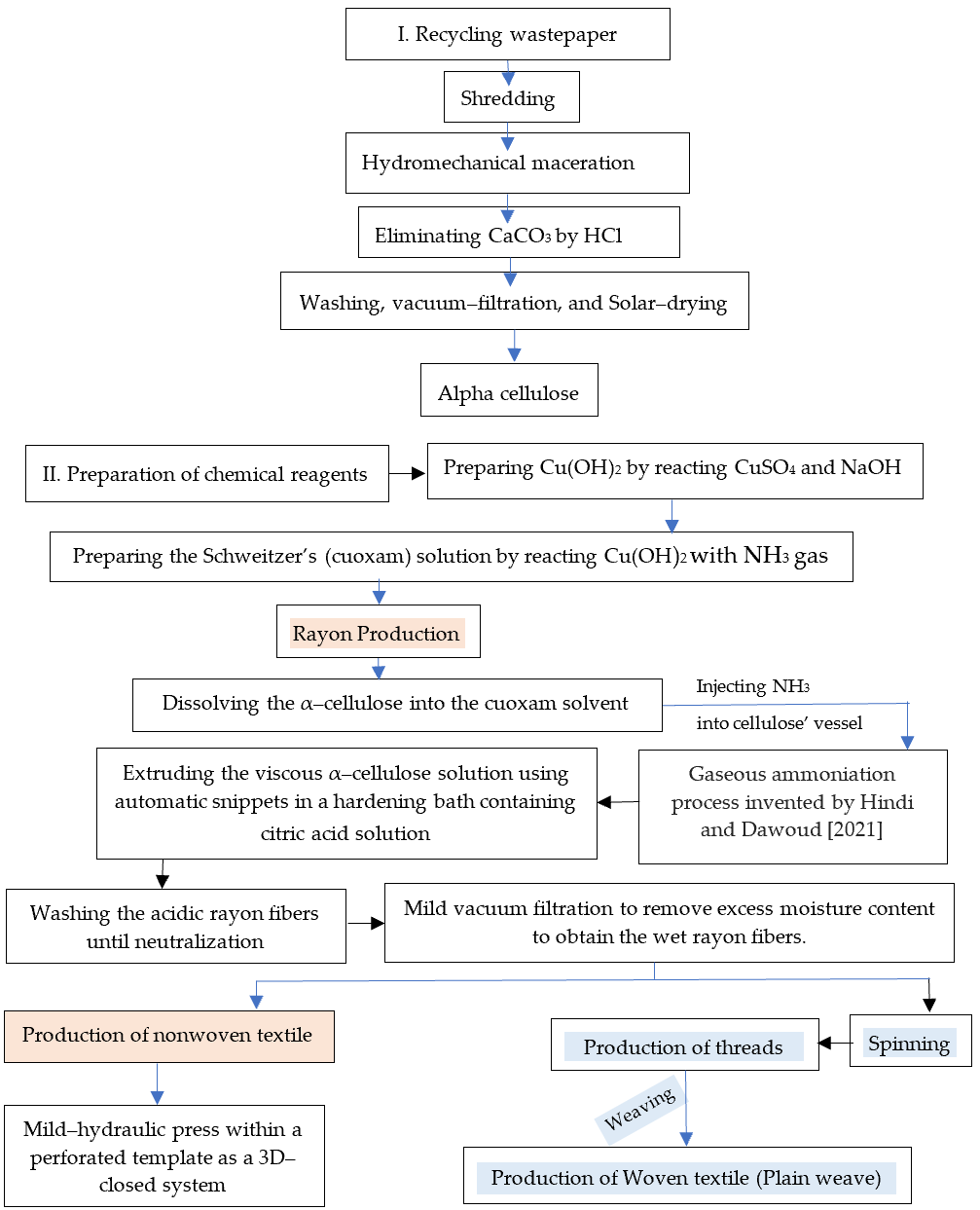
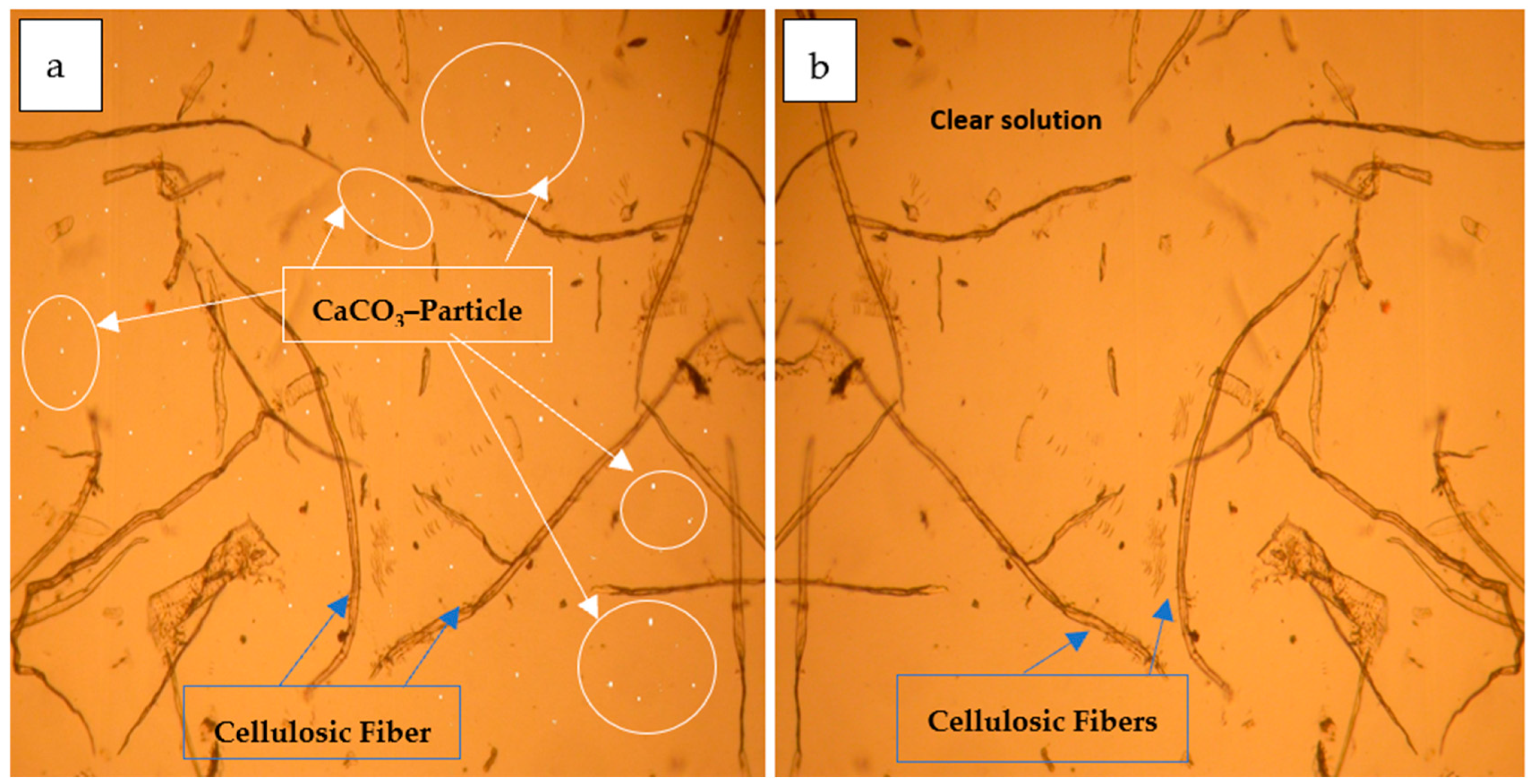
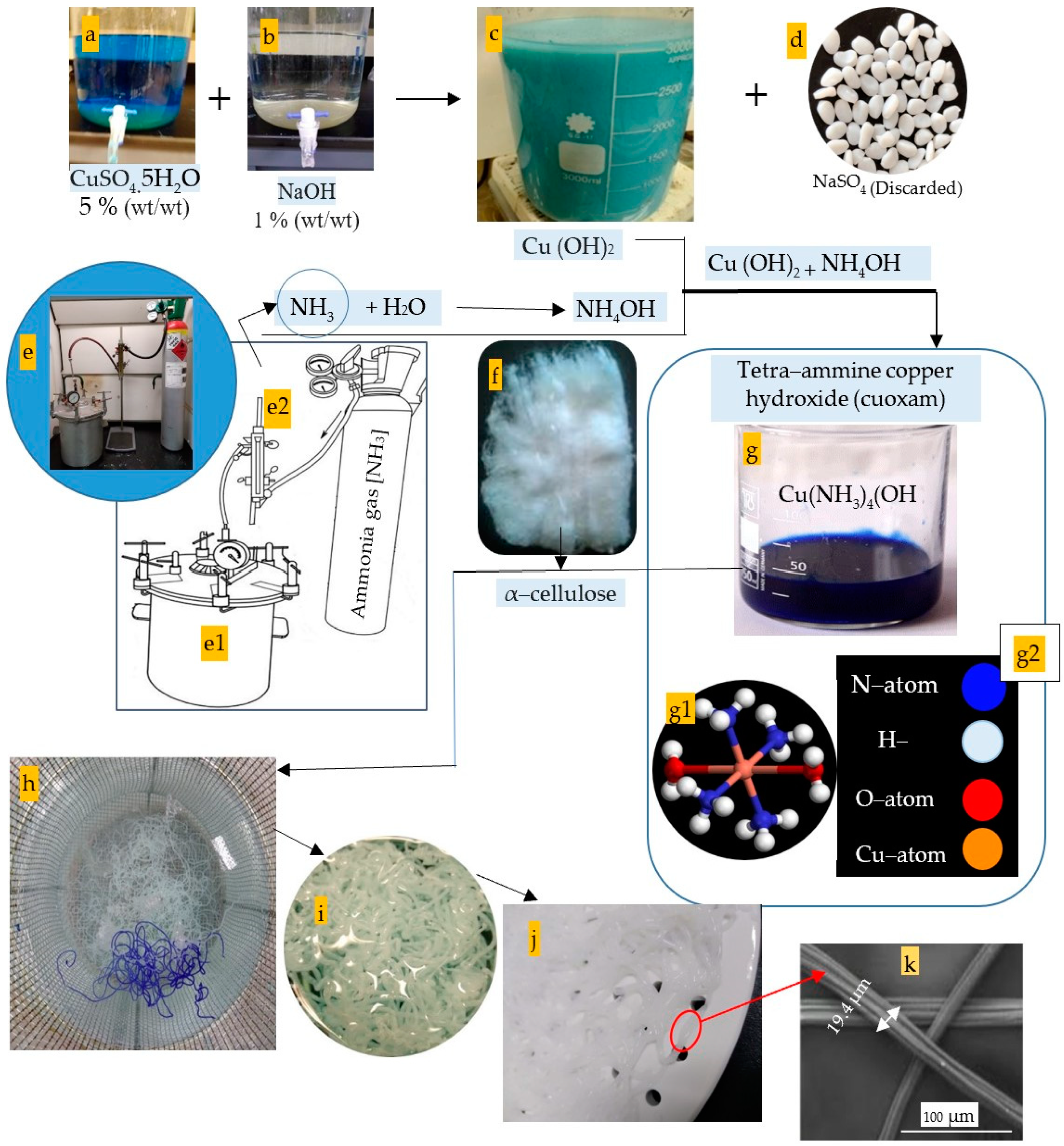


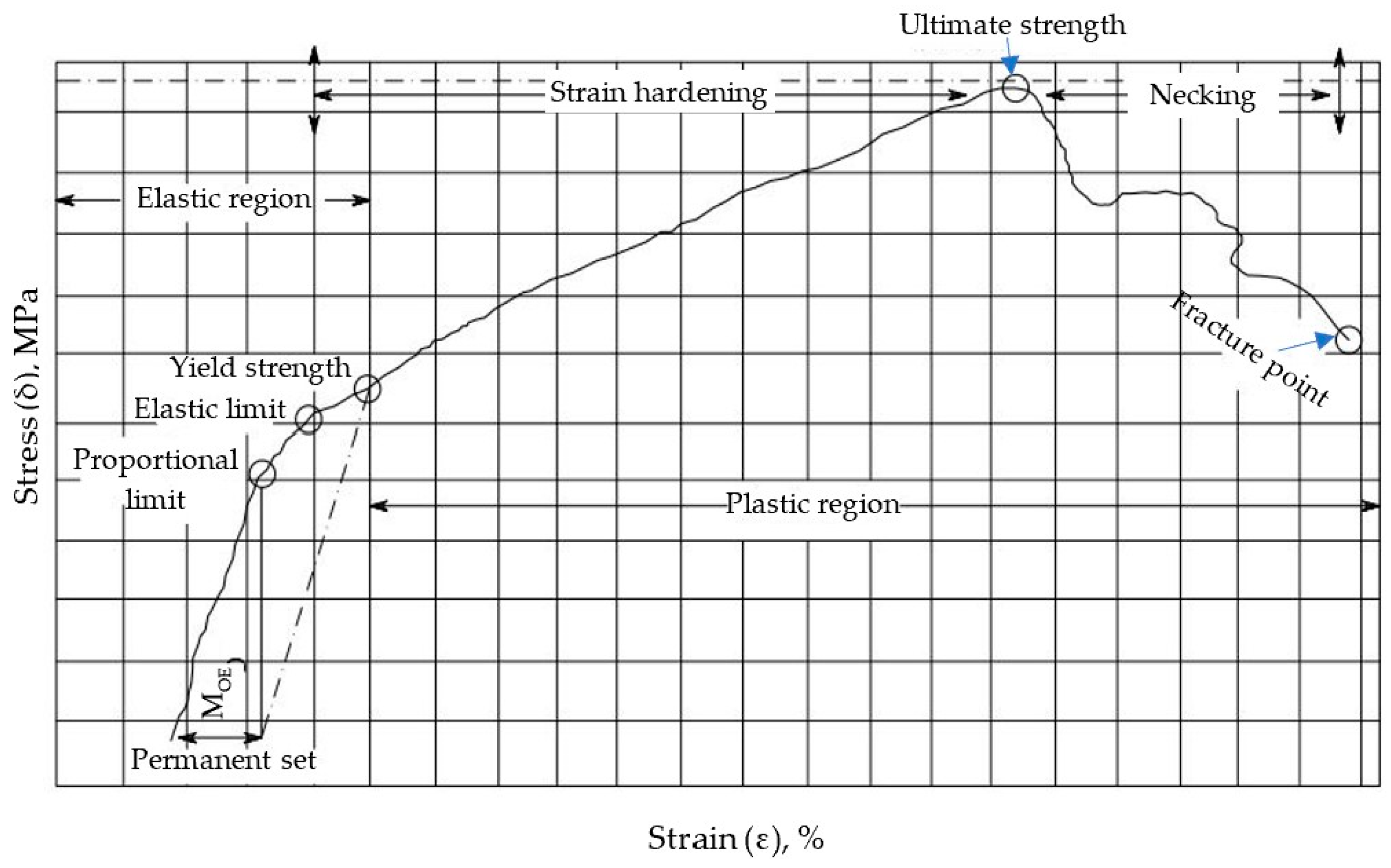
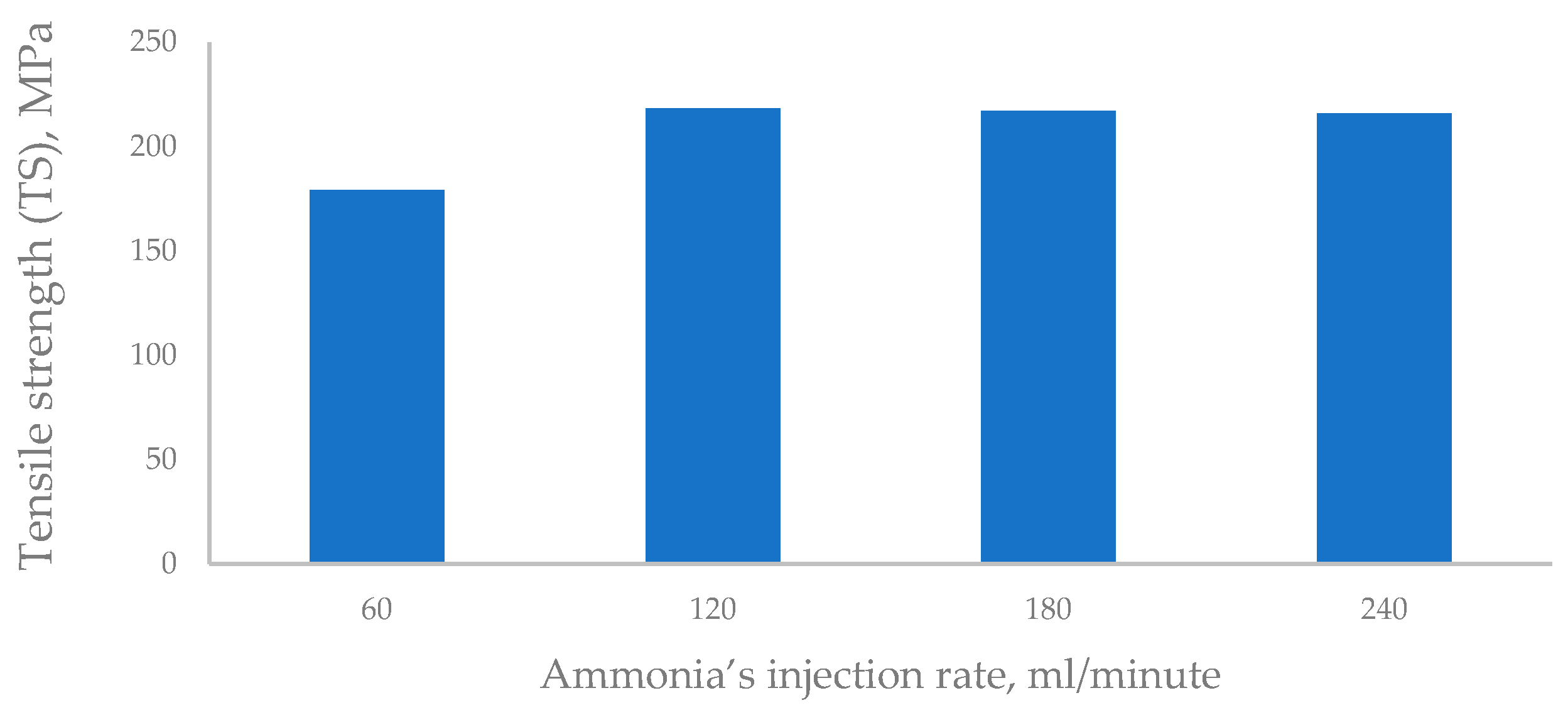

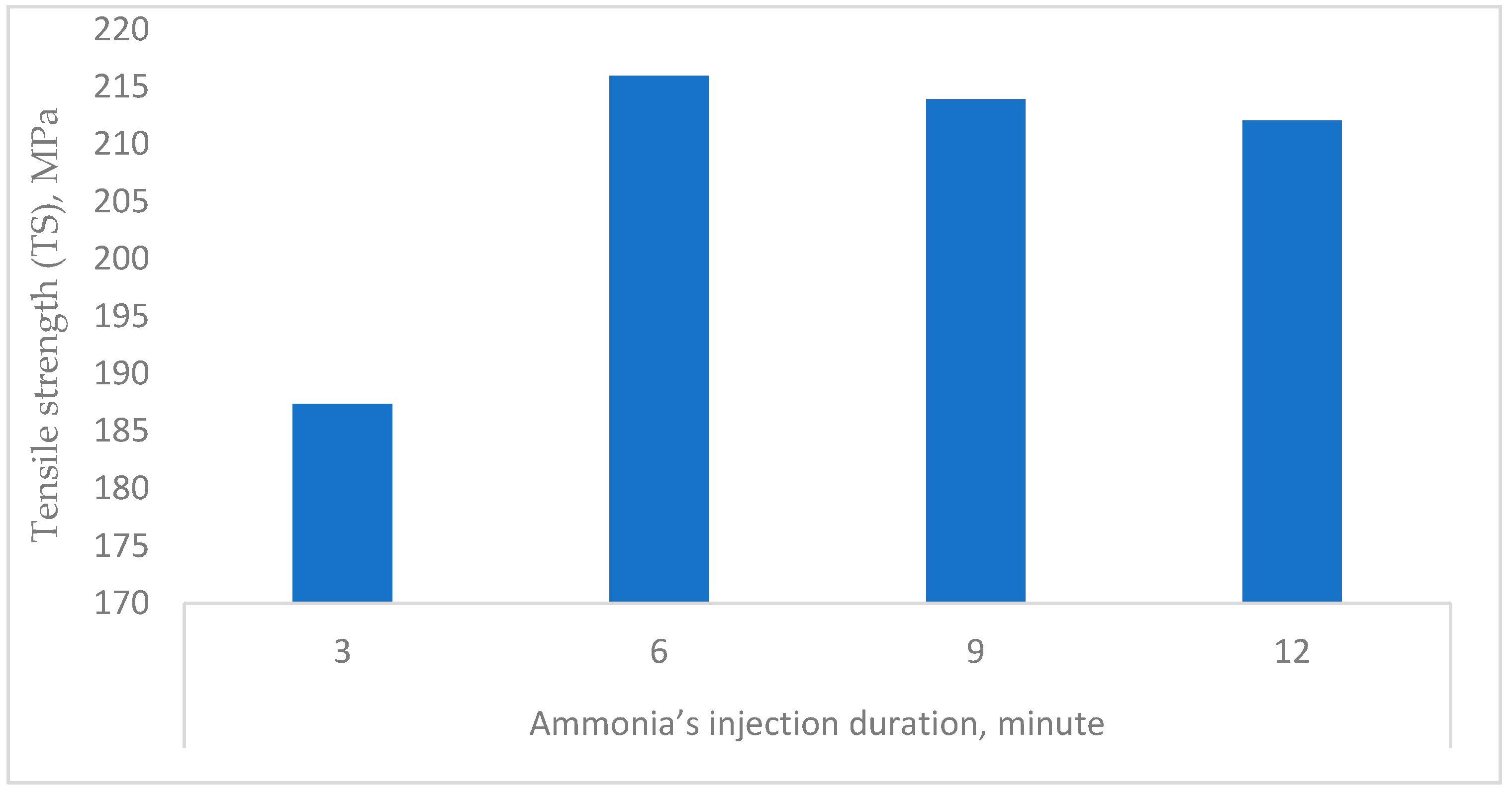


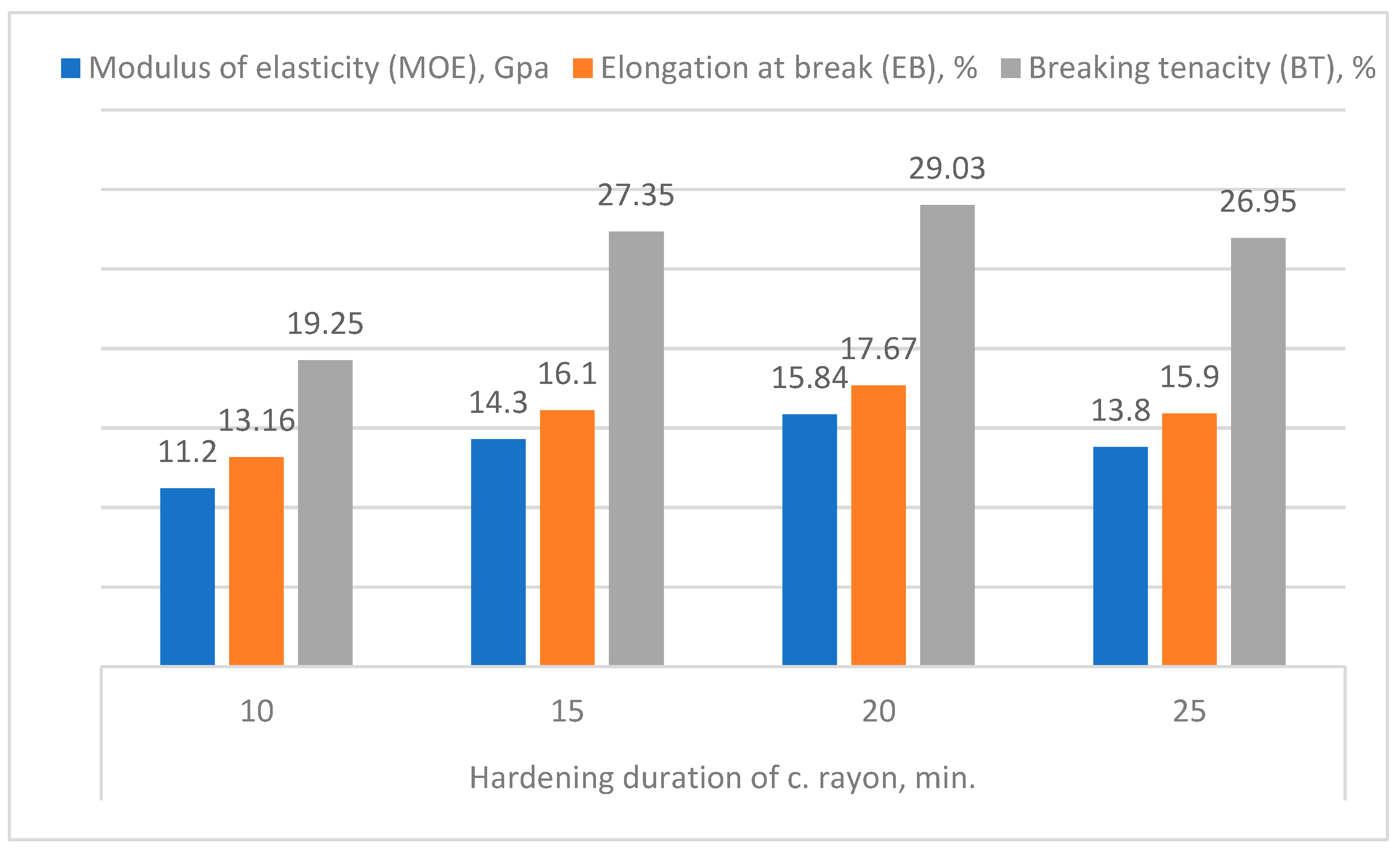

| CR | Formula | Concentration % (wt/wt) | The Reagent Role |
|---|---|---|---|
| Copper sulfate | CuSO4 | 5 | Produce copper hydroxide [Cu (OH)2]. |
| Sodium hydroxide | NaOH | 1 | |
| Copper hydroxide | [Cu (OH)2] | 80 | It is ammoniated to produce the cuoxam solution. |
| Ammonia gas | NH3 (gas) | 100 | Grafting four [NH3−] groups on copper hydroxide to produce the cuoxam solution. |
| Cuoxam solution | [{Cu(NH3)4}(OH)2] | 100 | Dissolving cellulose |
| Citric acid | C6H8O7 | 5 | Hardening the rayon fibers in the curing bath. |
| (A) | ||
| Expression | Equation | Unit |
| Staple length | Recording by a ruler | mm |
| Linear density (LD) | LD = 1000 W/L | Tex |
| W: the air-dry weight of a known length | g | |
| L: the known length of the c. rayon fiber | mm | |
| Fiber diameter | Estimating from SEM images | µm |
| (B) | ||
| Expression | Equation | Unit |
| Tensile strength (σt) | σt = Ff/A | MPa |
| Ff: Force at failure | N | |
| Cross-section area (A) | A = π × r2 = π (D/2)2 | (mm)2 |
| Fiber diameter (D) | D =2 r | mm |
| The ratio of circumference to diameter of a circle (π) | π = 22/7 | |
| Modulus of elasticity (MOE) | MOE = δ/ε | GPa |
| δ: Tensile stress | Pa | |
| Tensile Strain (ɛ) | ɛ = [∆L/Lo] = [(Lf − Lo)/Lo] | – |
| Elongation of the gage length (∆l) | ∆L = Lf − Lo | m |
| Lf: The final fiber length at failure | mm | |
| Lo: The initial fiber length at failure | mm | |
| Corrected (MOEc) | MOEc = MOE∗/[1 − {C× (E∗ × A/L)}] | GPa |
| E: the apparent stiffness calculated from the stress–strain curve | ||
| L: gauge length | ||
| Percentage of elongation at failure (EaF) | EaF = ∆Lf = [(Lf − Lo)/Lo] × 100 | % |
| Breaking tenacity (BT) | BT = [(B/W) × 2.54 × 10–5] | gf/Tex |
| B: Filament breaking load | bf | |
| W: Filament weight (W) | g | |
| (C) | ||
| Expression | Equation/measuring device | Unit |
| Cellulose yield of the wastepaper (αCY). | αCY = (W1/W2) × 100 | % |
| W1: Oven dry weight of the ∞–cellulose. | g | |
| W2: Oven dry weight of the wastepaper. | g | |
| Rayon yield (RY). | RY = (W3/W4) × 100 | % |
| W3: Oven dry weight of the rayon fibers. | g | |
| W4: Oven dry weight of the cellulose isolated from the wastepaper. | g | |
| Apparent density (AD). | AD = {D/(D − S)} × ꝭmedium | g.cm–3 |
| ꝭmedium: density of displacement medium. | g.cm–3 | |
| D: Oven dry weight of the c. rayon fiber. | g | |
| S: Weight of the suspended fiber in water. | g | |
| Moisture Content (MC). | MC = [(W5 − W6)/(W5)] × 100 | % |
| W5: Air dry weight of the c. rayon fiber. | g | |
| W6: Oven dry weight of the c. rayon fiber. | g | |
| The Moisture Regain (MR). | MR = [(W7 − W8)/W8] × 100 | % |
| W7: Water–saturated weight of the c. rayon fiber. | g | |
| W8: Oven dry weight of the c. rayon fiber. | g | |
| Volumetric Shrinkage (VS). | VS = [(1 − (L2/L1)] × 100 | % |
| L1: length of the oven-dried C. rayon fiber. | mm | |
| L2: length of the swelled c. rayon fiber obtained by immersing in boiling water for 30 s. | mm | |
| (D) | ||
| Expression | Equation | Unit |
| Crystallinity index (CI) | CI = [(Dcr1 + Dcr2)/Dt] × 100 | % |
| The total peak area (Dt) | Dt = [Ʃ(X2 − X1)(I1 + I2)/2] | mm2 |
| X1: The 1st X-coordinate of the trapezoid constituting a peak area (width). | 2θ° | |
| X2: The 2nd X-coordinate of the trapezoid constituting a peak width (width). | 2θ° | |
| I1: The lower Y-coordinate of the trapezoid constituting a peak (intensity). | a.u. | |
| I2: The upper Y-coordinate of the trapezoid constituting a peak (intensity). | a.u. | |
| Cristallite size (CS), | CS = Kλ/β1/2Cos θ | nm |
| K: The correction factor is usually taken to be 0.91 (0.1542 nm). | - | |
| λ: The radiation wavelength of X-rays incident on the crystal | - | |
| β1/2: The corrected angular full width at FWHM. | ||
| FWHM: The full width at half maximum of an XRD-peak. | ||
| θ°: The diffraction (Bragg) angle corresponding to the 200 plane. | ||
| Lattice spacing (LS) | LS = nλ/2sin θ° | nm |
| n: An ordinal number taking a value of “1” for diffractograms having the strongest intensity. | - | |
| Mass loss (ML) | ML % = [{(W1 − W2)/W1}]× 100] | % |
| W1: Initial rayon weight | g | |
| W2: Final rayon weight after heating | g | |
| Wct = Weight of the purified cellulosic fibrous at a certain moisture content heated from 0–500 °C. | g | |
| Heat change (HC) | using a Seiko & Star 6300 analyzer’s software. | μVs/mg |
| (E) | ||
| Expression | Equation | Unit |
| Intrinsic viscosity of the α–cellulose dissolved in cuoxam reagent (ղ) | ղ = Km × MW× α | |
| Km = 8.5 × 10−3 | mL/g | |
| MW: Molecular weight | g/mole | |
| α = 0.81 | ||
| Degree of polymerization (DP) | DP = MW1/MW2 | – |
| MW1: Total molecular weight of the rayon fiber. | g/mole | |
| MW2: Molecular weight of the glucopyranose monomer. | g/mole | |
| Property | C. rayon | Standard Limits | |||
|---|---|---|---|---|---|
| Value | References | ||||
| Fibrous | Staple length, mm | 44 ± 4.8 | 39 | [66] | |
| Linear density, Tex | 235 ± 4.31 | 94–244 | [23,70] | ||
| Fiber diameter, µm | 19.4 ± 1.49 | 54 | [23] | ||
| Mechanical | Tensile strength, MPa | 218.3 ± 3.37 | 360 | [99,100,101] | |
| Modulus of elasticity, GPa | 14.3 ± 0.28 | 0.5 ± 4–11 ± 4.3 | |||
| Elongation at break, % | 16.1 ± 0.33 | 5.3 ± 1.9–14 ± 3.8 | |||
| Breaking tenacity cN/Tex | 27.53 ±0.41 | 35 ± 3 | |||
| Physical | Yield α–cellulose, % | 90.3 ± 0.81 | 84.76 | [2] | |
| Rayon yield, % | 92.25 ± 1.17 | 72.47–88.27 | [16] | ||
| Apparent density, g.cm–3 | 1.54 ± 0.16 | 1.53 | [97] | ||
| Moisture content, % | 8.6 ± 0.98 | 10.2–12.75 | [16,66] | ||
| Moisture regain, % | 7.8 ± 0.76 | 10.57–14 | [16,20,91] | ||
| Volumetric shrinkage, % | 1.8 ± 0.24 | 1.5 | [96] | ||
| Crystallinity index (CI), % | 61.304 | 71.62 | [110] | ||
| Maximum mass loss (25 °C–500 °C), % | 56.77 | [47,90] | |||
| Heat change, μVs/mg | Endotherm | −884 | −784.49 | [11,47,90] | |
| Exotherm | +1247 | 879.29 | |||
| Net energy | 363 | 94.8 | |||
| Glass transition temperature (Tg), °C | 220° | [86] | |||
| Chemical | Molecular weight, g/mol | 64,800 ± 471 | 90,000–110,000 | [97] | |
| Degree of polymerization, Dalton | 400 ± 4.9 | 285–603.4 | [98] | ||
Disclaimer/Publisher’s Note: The statements, opinions and data contained in all publications are solely those of the individual author(s) and contributor(s) and not of MDPI and/or the editor(s). MDPI and/or the editor(s) disclaim responsibility for any injury to people or property resulting from any ideas, methods, instructions or products referred to in the content. |
© 2024 by the author. Licensee MDPI, Basel, Switzerland. This article is an open access article distributed under the terms and conditions of the Creative Commons Attribution (CC BY) license (https://creativecommons.org/licenses/by/4.0/).
Share and Cite
Hindi, S.S. Wastepaper-Based Cuprammonium Rayon Regenerated Using Novel Gaseous–Ammoniation Injection Process. Polymers 2024, 16, 2431. https://doi.org/10.3390/polym16172431
Hindi SS. Wastepaper-Based Cuprammonium Rayon Regenerated Using Novel Gaseous–Ammoniation Injection Process. Polymers. 2024; 16(17):2431. https://doi.org/10.3390/polym16172431
Chicago/Turabian StyleHindi, Sherif S. 2024. "Wastepaper-Based Cuprammonium Rayon Regenerated Using Novel Gaseous–Ammoniation Injection Process" Polymers 16, no. 17: 2431. https://doi.org/10.3390/polym16172431




